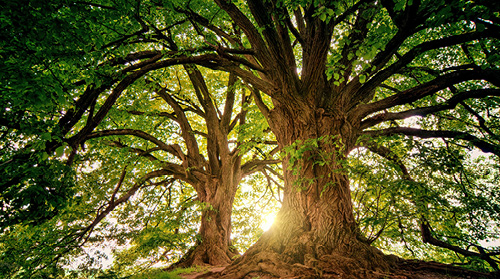Trees – we mostly take them for granted and, unless we work with them, probably don’t give them much thought in our everyday lives but it is worth considering the huge importance they have to our own health as well as that of the planet. When we really stop to look, they can fill us with wonder – particularly a big old tree – how many years has it been alive? What has happened in its lifetime? How have the landscape and people around it changed? Has its trunk been marked or scarred and what may have caused this?
As children one of the first things we learned about trees was that you could count the ‘rings’ on a cut trunk to tell how old it was and you could make wonderful patterns doing bark rubbings with a wax crayon and sheet of paper resting on the trunk. A favourite children’s book that I read myself, and went on to read to my own children, is The Magic Faraway Tree by Enid Blyton. The four children in the story had numerous adventures when they climbed this very unusual tree and met all sorts of amazing characters who lived in it. The imagination with which this story was written and that which it has inspired in so many readers, just goes to show how awe-inspiring these wonderful giants are.
Now as we are approaching spring after a cold winter, we can really appreciate the tiny new leaf buds appearing on the trees and watch as they grow and reclothe the naked branches. But more than this, numerous scientific studies have shown the health benefits of being amongst trees. Visiting forest environments can help lower blood pressure, reduce the stress hormone cortisol and suppress the activity of our sympathetic nervous system. Forest Bathing is a Japanese practice of being calm and quiet whilst amongst trees, breathing deeply to promote relaxation. It is believed to boost wellbeing in a natural way. Learn more and access Virtual Forest Bathing if you are unable to get out to visit a forest by clicking this link: Forestry England – Forest Bathing
In her book Biophilia: You + Nature + Home, Sally Coulthard discusses how humans need a connection with nature to be content, ‘people – since the beginning of time – must feel linked to their natural environment, and the other living things in it, not only to survive but to thrive’. She says ‘What’s fascinating is that what we feel intuitively about the benefits of being around trees is backed up by a robust body of research’. Studies show that hospital patients require less pain relief and heal more quickly if they have a view of trees from their window.
Trees Are The Key Week is a new awareness week that runs from Monday to Sunday, 20-26 March 2023 and always embraces the 21 March – the International Day of Forests. It is an initiative from UK Registered Charity, Word Forest
that works to combat the devastating effects of global warming and climate change by planting fast growing trees in the tropics, predominantly food bearing. The Week aims to raise awareness of the value of trees and what they do for us.
Between every two pines is a doorway to a new world – John Muir
Reference sources and further reading:
Woods, Trees and Long-term Mindfulness – Woodland Trust
walkmyworld – tree quotes
The Woodland Trust
RHS – Trees
Blog by Nicola Coughlin





